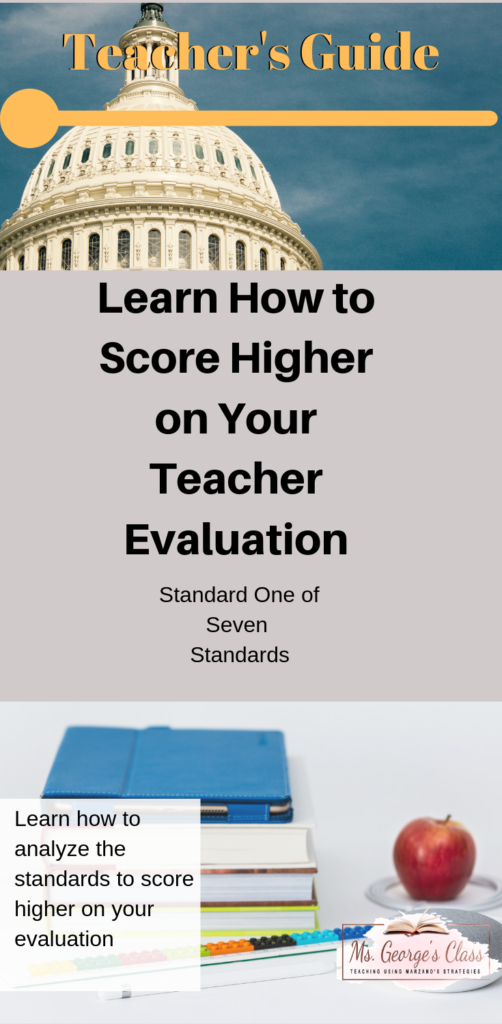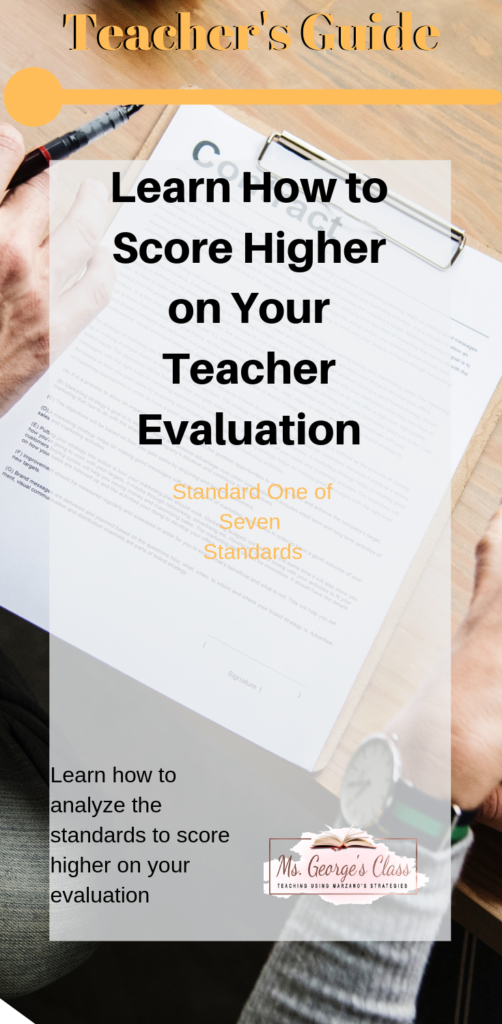
As teachers, we love when we get recognized for our hard work. The best recognition is from our annual evaluation. When we score high on our evaluation, we see that we are doing our job well. In the State of Ohio teachers
In Ohio, educators are evaluated on several teaching criteria. The evaluation rubric has seven areas of evaluating teacher’s performance or standards. This article will cover one of the areas in a systemic, analytical manner to help teachers improve their scores on the evaluation. The seven areas of evaluation are: standard 1 students, standard 2 content, standard 3 assessment, standard 4 instruction, standard 5 learning environment, standard 6 collaboration and communication, and standard 7 professional responsibility and growth. You may find more information about each standard in the book Standards for Ohio Educators. This a great source to understand each standard and conquer your goal of earning an accomplished teaching score.

A teacher’s performance is based on four levels: ineffective, developing, skilled, and accomplished. The goal is to aim for accomplished. How do you earn accomplished? You demonstrate excellent teaching skills and provide documentation of your evidence for each criteria. This entails planning and organizing your work. I recently went to Teachers Pay Teachers and purchased an Ohio Evaluation Binder to organize my documentation. I would recommend you do the same or create your own documentation binder. When analyzing teaching standards, having the rubric available will assist you in understanding the performance assessment. You can click on this link to get the Ohio Department of Education Teacher Performance Evaluation Rubric (this is now a Word Document and you click on the link at the bottom of the page). Marzano has included a supplemental to the teacher evaluation model that is aligned with the Ohio State Standards. Also, the book, Standards for Ohio Educators, is where I gathered most of my information. The Ohio Department of Education has included this book on their website, click here to view the book. The rubric is organized differently from the standards. They are organized in this manner:
| The Focus of Teaching and Learning | The Conditions for Teaching and Learning | Teaching as a Profession |
| Standard 1: Students | Standard 5: Learning Environment | Standard 6: Collaboration and Communication |
| Standard 2: Content | Standard 7: Professional Responsibility and Growth | |
| Standard 3: Assessment | ||
| Standard 4: Instruction |
Focus of Teaching and Learning has four standards. We will focus on “Standard 1: Students” within this article. I am planning on addressing all the standards in future posts.
In the book Standards for Ohio Educators, “Standard 1: Student,” states, “Teachers understand learning and development and respect the diversity of the students they teach” (15). This standard addresses a teacher’s knowledge on how students learn, learning styles, and an understanding of students’ backgrounds and experiences. As a result, a teacher uses this information to help students learn and achieve at high levels.
The standard has five elements that will help you further demonstrate your understanding of the knowledge of your students. The elements are:
1.1. Teachers display knowledge of how students learn and of the developmental characteristics of age groups.
1.2 Teachers understand what students know and are able to do and use this knowledge to meet the needs of all students.
1.3. Teachers expect that all students will achieve to their full potential.
1.4 Teachers model respect for students’ diverse cultures, language skills, and experiences.
1.5 Teachers recognize characteristics of gifted students, students with disabilities and at-risk students in order to assist in appropriate identification, instruction and intervention.

Let’s look at standard element 1.1. There are three indicators within the book Standards for Ohio Educators: proficient, accomplished, and distinguished. A proficient teacher demonstrates an understanding of human development and understanding of students. The teacher uses this information to plan instruction and make recommendations to improve learning. The accomplished teacher uses that information as a building block to scaffold and analyzes individuals and groups to create a lesson that meets a learner’s need. A distinguished teacher meets all the indicators, in addition to supporting other teachers’ understanding of student development. In your evaluation preconference, display how you gained knowledge about your students through test scores, learning style surveys, and other background about specific students.
Standard element 1.2 describes understanding what students know and what they are able to perform. A proficient teacher gathers information about prior learning and delivers instruction based on the information. An accomplished teacher incorporates the student’s prior learning and presents concepts at different levels of complexity and prepares differentiate instruction to meet the needs of all students. Teachers that lead the design and implementation of assessing individual students are identified as distinguished. You can display your lesson plans along with the state extended standard, which shows complexity levels of each standard. Click here for the English Language Arts extended standards. This is a great tool to support your knowledge of standard one.
Standard element 1.3 focuses on having high expectations for all students. A proficient teacher establishes and communicates high expectations by focusing on students’ strengths. They also display a belief that all students can learn and consistently help students to achieve their best. In addition to those qualities, an accomplished teacher sets challenging expectations for each individual student and influences students to continue to progress. As a distinguished teacher, he/she is able to assist others within his/her school and district to set a high expectation. You can provide documentation such as a rubric that challenges students to write about an abstract or difficult concept. This will demonstrate your ability to provide persistent approaches for all your students.
Standard element 1.4 evaluates how you model respect for students. Within this element, a proficient teacher will display knowledge of interest about a student’s culture, set clear rules about respecting others values and cultures, maintaining rapport with individual students, and value the native language of students. An accomplished teacher will meet those elements and analyze his or her own biases, implement strategies that support the ESL learners, and foster a sense of community to learn about other cultures. The distinguished teacher will model behavior and work with all cultures to ensure that all students are valued. This could be displayed through lessons written in two languages, culture months recognized, or participating in activities that encourage inclusion of all cultures.
Overall, teachers are to uphold a level of understanding students on a holistic level. Standard one focuses on students learning styles, prior knowledge, culture background, and executing high expectations. It can be challenging to earn accomplished on your State of Ohio evaluation, but if you provide documentation in your pre and post conferences for each standard element, you will have a higher chance to earn accomplished. In the comments below, tell me about your experience with the evaluation system. Have you ever earned accomplished? After reading this article, how are you going make changes to be a better teacher?
Work Cited
Ohio Department of Education. Standards for Ohio Educators, 2007.




Leave a Reply